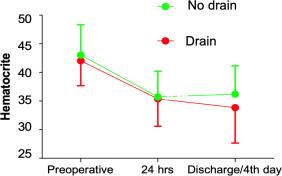Wound drain in lumbar arthrodesis for degenerative disease: an experimental,multicenter, randomized controlled trial |
| |
| Affiliation: | 1. Department of Orthopaedic Surgery, Spine Center, Clínica Las Condes, Santiago, Chile;2. Instituto Traumatológico de Santiago, Santiago, Chile;3. Research and Clinical Epidemiology Unit, Finis Terrae University, Santiago, Chile;4. Department of Orthopaedic Surgery, Clínica Santa Maria, Santiago, Chile;5. Clínica MEDS, Santiago, Chile;6. Department of Orthopaedic Surgery, Clínica Universidad de los Andes, Santiago, Chile |
| |
| Abstract: | 
INTRODUCTIONDrains for surgical wound management are frequently used in spine surgery. They are often used to decrease the incidence of postoperative hematoma and decrease wound tension. No conclusive evidence in the literature supports using drains to avoid complications in degenerative lumbar spine surgery.PURPOSEWe aimed to evaluate wound drains in patients with lumbar arthrodesis for degenerative disorders based on clinical outcomes, complications, hematocrit, and length of stay.STUDY DESIGNA multicenter randomized prospective controlled clinical trial.PATIENT SAMPLEWe enrolled surgical candidates for posterior lumbar decompression and fusion surgery for degenerative disorders from October 2019 to August 2021. Patients were randomized into the drain or nondrain group at nine hospitals. The inclusion criteria were as follows: patients aged 40 to 80 years with lumbar and radicular pain, lumbar degenerative disorder, and primary surgery up to three levels. The exclusion criteria were bleeding abnormalities, bleeding >2,500 mL and dural tears.OUTCOME MEASURESPreoperative data including Oswestry disability index (ODI), SF-36, lumbar and lower extremity visual analog scale (VAS), body mass index (BMI), hematocrit, and temperature were recorded. Surgical parameters, including surgical time, complications, estimated blood loss (EBL), postoperative temperature and hematocrit (days 1 and 4), dressing saturation, and length of hospital stay (LOS), were registered.METHODSThe two groups were assessed preoperatively, perioperatively and at the 1-month follow-up. A REDCap database was used for registration. Data analysis was performed using classical statistics.RESULTSOne hundred one patients were enrolled using the Redcap database, and 93 patients were evaluated at the final follow-up. Forty-five patients were randomized to the drain group, and 48 were randomized to the nondrain group. The preoperative characteristics were equivalent in both groups: demographic aspects, pain, ODI, SF-36, BMI, hematocrit, and spine pathology. Surgical time, EBL and complications were similar, with no difference between the groups. No difference was found between BMI and complications. No difference was observed in dressing saturation or postoperative temperature between the groups. The postoperative day 4 hematocrit was higher in the nondrain group [36.4% (32–39)] than in the drain group [34% (29.7–37.6)] without statistically differences (p=.054). The LOS was higher in the drain group [4 (3–5) days] than in the nondrain group [3 (2–4) days] (p=.007). The quality-of-life score, SF-36, was higher in the nondrain group [67.9 (53.6–79.2)] than in the drain group [56.7 (49.1–66)] (p=.043).CONCLUSIONSNondrain patients presented shorter LOS and better outcomes, with similar complication rates. No difference was found between BMI and complications. Based on this study, in patients undergoing primary posterior spinal decompression and fusion up to three levels for degenerative lumbar disorders, we do not recommend the use of postoperative drains. |
| |
| Keywords: | |
| 本文献已被 ScienceDirect 等数据库收录! |
|

